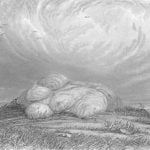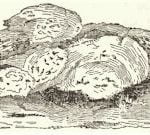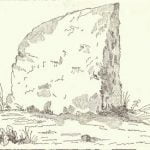
This canton of the Iroquois nation, deduces its origin in a remote age, from the Onondagas, with the language of which, the Oneida has the closest affinity. According to a tradition which was related to me, and which is believed to be entitled to respect, they are descended from two persons, who, in their obscure ages, and before a confederation had been thought of, went out from the people at Onondaga, and first dwelt at the head of the Oneida river. After increasing in numbers, they removed to the outlet of the Oneida creek, which flows into Oneida Lake. Here they fortified themselves, and farther increased in numbers and power. Remains of this fortification are said still to exist. Their next removal was up the Oneida creek valley, to the storied locality of the Oneida stone, from which, by a figure of speech, they represent themselves to have sprung. This stone is in the town of Stockbridge, Madison County. It lies on a very commanding eminence, from which the entire valley, as far as the Oneida Lake, can be seen in a clear atmosphere. The day of my visit being hazy at a distance, the lake could not be seen, although the view down the valley was both magnificent and picturesque. This eminence was formerly covered with a butternut grove. Old, and partly decayed trees of this species, still remain in a few places. The ancient town extended in a transverse valley, south of this ridge of land, covered as it was, with nut wood trees, and was completely sheltered by it, from the north winds. A copious and clear spring of water issued at the spot selected for their wigwams. Here in seclusion from their enemies, the tribe expanded and grew in numbers. When it was necessary to light their pipes, and assemble to discuss their national affairs, they had only to ascend the hill, through its richly wooded grove, to its extreme summit, at the site of the Oneida stone. This stone, represented on the succeeding page, became the national altar.

Standing at its side, at a probable elevation of 400 or 500 feet above the Stanwix summit, they could survey the whole valley of the Oneida; and a beacon fire lighted here, was the signal for assembling their warriors, from all the surrounding lateral plains and valleys. Time and usage rendered the object sacred, and as they expanded into nationality and power, while located around it, their sages asserted with metaphorical truth, that they sprang from this rock. Stone in this language is Onia. They called themselves, Oniota-aug, people of, or who sprung from the stone. There is some variety in the pronunciation. The Mohawks call them Oneota. The French wrote it Aneyoute, the English and Dutch, Oneida, which latter has prevailed. Neither retained the plural inflection in aug, which carries the idea of people.
With a knowledge of these traditions, I approached the spot with deep interest. It occupies the extreme summit, as shown in the print. The first feeling, on approaching it, was one of disappointment at its size, but this feeling soon subsided in the interest of its antiquity and national associations. It is a large, but not enormous boulder of syenite, 1 of the erratic block groupe, and, consequently, geologically foreign to the location. There are no rocks of this species in situ, I believe, nearer to it. in a northerly or easterly direction, than the Kayaderosseras or the Adirondach mountains. 2 The summit upon which, partly embedded, it reposes, is now a cleared field, in grass. A few primitive and secondary boulders, all of lesser size, are strown about the ridge, and several of weight and magnitude rest upon its flanks, and in the vallies at its base. One of the largest of these is the White Stone at the spring, which has been spoken of, I think, in some early notices of the Oneidas, as the true Oneida stone; but this opinion is erroneous, by the concurrent testimony of red and white men, cognizant of the facts, whom I consulted. This white stone, figured below, has been removed, by the proprietor of the land, 3 from its ancient position near the spring, to constitute part of a stone fence; it is a carbonate of lime.

Tshejoana, one of the Oneidas, who served as my guide in visiting this interesting location, took me to see still another stone, of note, lying a mile or more distant, in a southerly direction, on a farm of Gen. Knox. This stone, of which a figure is annexed, I found to be a large boulder of dark, compact limestone, with organic remains. It was observable that the encrinites contained in this mass, were red. My Indian guide would have this color to be the result of the ancient Indian war paint. But the most striking characteristic of this rock, aside from its massy and flattened size and channelled center, consists in the evidences it affords of the action of water, in rounding and polishing it. In several places, my guide would have this wearing effect to have been produced by the rubbing and sharpening of the Indian war axes; for he averred that it was customary for war parties who went out south against the Cherokees, to come and sharpen their axes upon this stone, and paint themselves for war. Whatever there was in this custom, I think he was probably mistaken in his locality; yet it is a question in which others may differ. At any rate, geology had been quite beforehand with the Oneida legendary and philosopher, in producing and accounting for these two phenomena, namely, the red color and smoothed and channelled surfaces. Geology having been mentioned, I may add the following incident. I told Skanawadi, one of my guides, while standing at the Oneida stone, lying on its proud ancient elevation, that there was no stone like this, in place, till we went north to the Adirondachs or Tehawas, or great lakes, and that this block of syenite had been brought here by the ocean, when it covered the whole land, and left on its recession. He replied, after a moment’s reflection, that he believed this.

At the time the Oneidas came to fix their location at this stone, the Konoshioni or Iroquois had not confederated. This people, in the early eras of their history, like the Algonquins, sent out individuals and bands, who became powerful, and assumed the character of separate and independent tribes, making war and peace and libitum. If this mode of multiplication be compared to the lower orders of creation, it had some striking analogies with it. Like the bear and the hawk, the moment the young member was ready to quit the parent lair or nest, it had not only to forage for subsistence, but to defend itself against other bears and hawks, and all other claimants to the food of the forest. To make war is, in fact, the first and the last act of sovereignty of the pettiest of all our aboriginal tribes.
War is with them the road, and the only road to fame, and the readiest way to secure a supply of spontaneous food. They fight to increase or defend the boundaries of their hunting grounds. Thus, doubtless, arose the first difficulties between the Oneidas and the other branches of the Iroquois. As soon as they we’ve important enough to be noticed, and bold enough to defend themselves, they had to raise barriers around their villages, and when these were carried, as they probably were, or were threatened to be, at two points, on the Oneida waters, they fled to the hill country, at the site of the Oneida stone. How long they abode here, and made it the seat of their council fire, we can only conjecture. They cannot and do not pretend to tell. Wisdom, at length, taught the Iroquois sages, that they had enemies enough, without fighting with each other, and the idea of a confederation was suggested. Tradition has preserved the name of Thaunowaga as the original suggested: but it has preserved nothing more of his biography. The delegate from the Oneidas was Otatschechta. That he came from, and lived, the locality of the stone and was renowned for his deeds and wisdom, is probable. This comprises the brief biography of two celebrated aboriginal sages and statesmen. Three periods of transference, of their council fire, have been named, all of which were probably prior to the confederation. Their fourth remove was down the valley to the present site of Oneida Castle a place which then, as now, they called Kunawaloa, meaning a man s head on a pole. At this place they lived and held their council fire, when the Dutch, in 1609, discovered and ascended the Kohatatea, or, Hudson River. Such are the accounts of their sachems and wise men. It is a general confirmation of them, that the other members call them Younger Brother.
By another and older Indian tradition, an earlier date is assigned to the Oneida canton, which is regarded as one of the original subdivisions of the generic stock. It represents this stock as moving from the west to the east, and at another period, returning towards the point of sun-setting, leaving the several separate tribes, or cantons, in their order as they passed. In this migration, the Oneidas are named as the second in geographical position and order of chronology.
They located themselves, says the Tuscarora annalist, 4 at a stream called Kaw nah taw te rub, or Pineries, a tributary, of the Susquehanna, which originates according to this authority, in Allen’s lake, ten miles south of Oneida Castle. They were called Ne haw retahgo, 5 or Big-Tree, a name, it may be remarked, which does not occur as the patronymic for this tribe in other authors, nor has it been retained by them. The distance and course denoted, coincide very nearly with that of the Oneida stone. It is not known, however, that any tributary of the Susquehanna exists in that vicinity.
The two traditions may indeed be reconciled to truth, by supposing the latter the more ancient one, and that the Onondaga families before mentioned, constituted a subsequent accession to, and union with a band who had seated themselves at a prior era, at the spot denoted; or this band may have remained there, on the general passage of the people eastward, and thus been the nucleus of the tribe, on the general return of the people west. In any view, however, they were called and are still called by the Iroquois, “Younger Brother,” which must be considered conclusive, that their nationality is of a period subsequent to that of the Mohawks, Onondagas, Cayugas, and Senecas. This fact too, is adverse to the theory, which has too much the aspect of a mere theory, that the re-migration of the Iroquois westward from the Atlantic, proceeded like a marching army, leaving tribes here and there as they went, in a regular chronological order, each of which took a name, and “altered,” as his phrase is, the language. The writer seems all along, to have had the Jewish Tribes in his mind. The truth is, ethnologically speaking, no tribe or nation, alters by an authoritative decision, or pre-thought, its language or idioms. Such alterations flow from time and circumstances. Least of all, do wandering savage tribes gravely determine to “alter” their dialects. Accident, usage, or caprice, little by little, and at long intervals, is the parent of new dialects and languages.
A few deductions may be added. By data before introduced, it will have been seen that it is probable the present confederation, whatever had preceded it, did not take place till about 1539, or seventy years before the arrival of Hudson. It may be considered as probable, that the Oneidas did not remove from the Oneida stone into the valley and plains of Oneida Castle, until after the event of the final confederation between the Five Tribes, gave them security against internal enemies. The date of this transfer of the council fire, is rather remote, but not very ancient. A new forest has grown upon the old cornfields which were once cultivated at their ancient settlement at the Oneida stone. The appearance of corn hills in rows, is still clearly perceptible in some parts of this forest. To an inquiry how such a preservation of the outlines of corn hills could be possible, my informant, who was an Oneida, answered, that in ancient times, the corn hills were made so large, that three clusters of stalks or sub-hills were raised on each circle or hill. There being no ploughs or other general means of turning up the earth, the same hill was used year after year, and thus its outlines became large and well defined. In a black walnut tree, standing on the site of one of these ancient corn-fields, which was partly cut, and partly broken off, I counted an the cut part, one hundred cortical layers, and measuring the broken part, estimated it to have 140 more. Allowing a year for each ring, the commencement of the growth was in 1555, or 16 years after the supposed date of the confederacy, and 290 years from the present date.
The remaining history of the Oneidas can only be glanced at, but has some points of peculiar interest. They are the only tribe of the ancient Konoshioni who adhered to us, at least the better part of them, in our life and death struggle of the revolutionary war, saving some portion of the Tuscaroras; whose aid, however, is justly due to the Oneida influence. It was by the Oneidas that the Tuscaroras were brought off from the south. The Oneidas had long distinguished themselves in their war excursions against the southern Indians. Their traditions are replete with accounts of these war parties against the Oyada, or Cherokees. They had found allies at the south in the Tuscaroras, who were themselves engaged in desperate wars, at various periods, against the Catabas, and Cherokees, and others. Besides this, Iroquois tradition claims the Tuscaroras as one of their original cantons, or rather as a band of the original Eagwe Heowe, who had, in early times gone south. 6 And when a crisis happened in their affairs, they nobly went to their relief, and seated them on their western confines, between themselves and the Onondagas, where they remained during the revolution. The Oneidas bore their full share in the long and bloody wars waged by Iroquois for more than two centuries, against the French in the Canadas, and against the distant Algonquins, Hurons and Illinese. And he who scans the ancient records of treaties and councils, will find that their sachems were represented in the conferences assembled on this continent, by the kings and potentates of Europe, who planted colonies at various times, between the respective Gulfs of Mexico and the St. Lawrence. After the flight of the Mohawks, in 1776, they were in the van of the Konoshioni, and to use their symbolic phraseology, stood in the eastern door of the Long House. When the mixed Saxon population of New York and New England began, after the war of 1776, to move westward, the Oneidas first felt the pressure upon their territory. By siding with the colonists, they had secured their entire ancient domain, from which they ceded to the State, from time to time, such portions as they did not want for cultivation, taking in lieu money annuities. Nor did they fail to profit, in a measure, by the example of industry set before them in agriculture and the arts. For a while, it is true, they reeled before the march of in temperance, and sunk in numbers, but many of them learned the art of holding the plough. From the earliest times they were noted, along with their more western brethren, for the cultivation of Indian corn, and the planting of orchards. They also became tolerable herdsmen, and raised in considerable numbers, neat cattle, horses and hogs.
To preserve their nationality, their sachems, about the year 1820, sent delegates west to look out a location for their permanent residence. They purchased a suitable territory from the Monomonees of Wisconsin, a wandering and non-industrious race, seated about Green Bay, and expended a part of their annuities in the payment. This turned out a wise measure. They soon began to remove, and have at this time a very flourishing settlement on Duck River, in that territory. At that location they have established schools, temperance societies and a church. They bear a good reputation for morals and industry, and are advancing in civilization and the arts.
By an official return of the date of 1844, they numbered 722 persons at that settlement. Two hundred and ten are still seated within the boundaries of New York, mostly in Oneida county. They are a mild people, of a good stature, and easy manners, and speak a soft dialect of the Iroquois, abounding in the liquid, which, together with a mild enunciation, imparts a pleasing character to their speech.
Citations:
- A specimen of the rock before me, brought thence, consists of flesh colored feldspar, quartz and hornblende.[
]
- If the passage of the Mohawk through the Astorenga or Astogan hills, at Little Falls, discloses syenite, I am not aware of the fact.[
]
- Mr. Job Francis.[
]
- Cusick.[
]
- In Tuscarora.[
]
- Vide Cusick’s pamphlet.[
]
